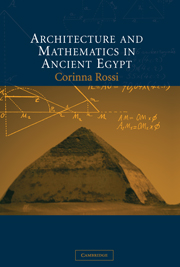Book contents
- Frontmatter
- Contents
- List of illustrations
- List of tables
- Preface
- Acknowledgments
- List of abbreviations
- Part I Proportions in ancient Egyptian architecture
- Part I Ancient Egyptian sources: construction and representation of space
- Part III The geometry of pyramids
- Conclusion to Part III: Interpreting the slope of pyramids
- An overview
- Appendix: List of Old and Middle Kingdom true pyramids
- Bibliography
- Index
Conclusion to Part III: Interpreting the slope of pyramids
Published online by Cambridge University Press: 27 February 2010
- Frontmatter
- Contents
- List of illustrations
- List of tables
- Preface
- Acknowledgments
- List of abbreviations
- Part I Proportions in ancient Egyptian architecture
- Part I Ancient Egyptian sources: construction and representation of space
- Part III The geometry of pyramids
- Conclusion to Part III: Interpreting the slope of pyramids
- An overview
- Appendix: List of Old and Middle Kingdom true pyramids
- Bibliography
- Index
Summary
In general, Old and Middle Kingdom pyramids appear to have been built on the basis of a number of geometrical models represented by right-angled triangles, which might have acted as guides during construction. A brief examination of the later pyramids seems to point in the same direction. Old Kingdom main pyramids follow a slow but constant tendency to increase their steepness. This evolution was interrupted in the Middle Kingdom, probably because of a change in building technique and the introduction of mud-brick instead of stone for the inner core, but it was resumed again after the first experiments. Secondary pyramids, however, follow two different patterns: until Userkaf, satellites and pyramids of queens had the same slope as the main pyramid but then, starting from Sahura, they became steeper. After two attempts with a seked of ⅔ cubit, the seked ½ cubit became the model for the majority of the secondary pyramids down to the end of the Middle Kingdom.
Once the pyramids have been classified according to their proportions, it is possible to ask further questions. Khufu, for example, used the slope which Snefru had adopted to finish Meidum. It is difficult to establish, however, to whom the kings who later adopted this slope meant to refer. Unlike any other king, the figure of Snefru, the ‘Beneficent King’, was worshipped down to the Ptolemaic Period, while Khufu's pyramid remained the largest ever built in ancient Egyptian history.
- Type
- Chapter
- Information
- Architecture and Mathematics in Ancient Egypt , pp. 236 - 238Publisher: Cambridge University PressPrint publication year: 2004



